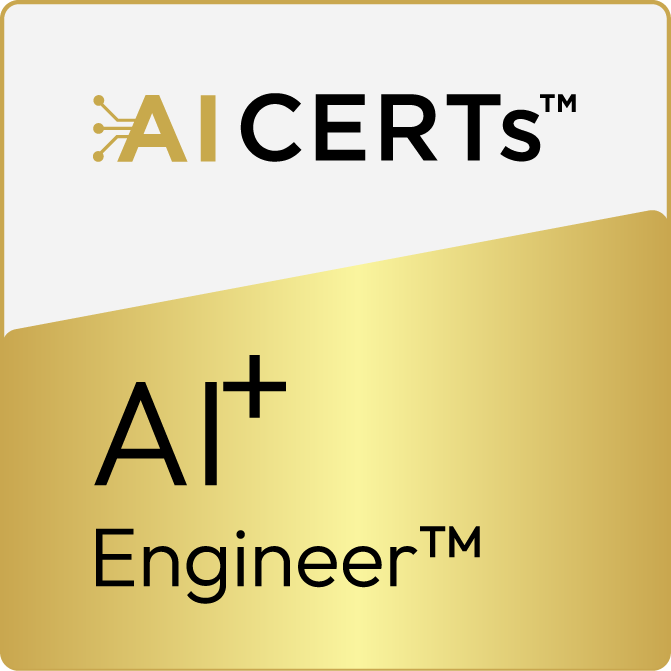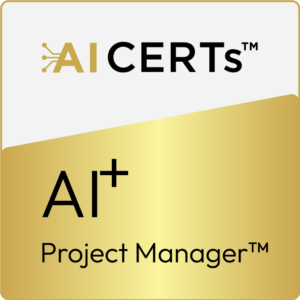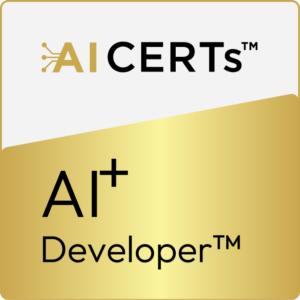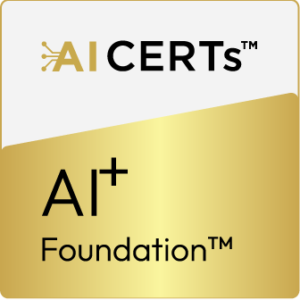Description
AI+ Engineer (5 Days)
Program Detailed Curriculum
Executive Summary
The AI+ Engineer certification program offers a structured journey through the foundational principles,
advanced techniques, and practical applications of Artificial Intelligence (AI). Beginning with the
Foundations of AI, participants progress through modules covering AI Architecture, Neural Networks,
Large Language Models (LLMs), Generative AI, Natural Language Processing (NLP), and Transfer Learning
using Hugging Face. With a focus on hands-on learning, students develop proficiency in crafting
sophisticated Graphical User Interfaces (GUIs) tailored for AI solutions and gain insight into AI
communication and deployment pipelines. Upon completion, graduates are equipped with a robust
understanding of AI concepts and techniques, ready to tackle real-world challenges and contribute
effectively to the ever-evolving field of Artificial Intelligence.
Course Prerequisites
AI+ Data or AI Developer course should be completed
Basic understanding of Python
Basic Math: Familiarity with high school-level algebra and basic statistics
Python Programming: Proficiency in Python is mandatory for hands-on exercises and project work.
Computer Science Fundamentals: Understanding basic programming concepts (variables, functions,
loops) and data structures (lists, dictionaries).
Module 1
Foundations of Artificial Intelligence
1.1 Introduction to AI
Historical Perspective: Brief exploration of the historical evolution of Artificial Intelligence, tracing key
developments and milestones that have shaped the field.
What is AI? : Definition and fundamental concepts of Artificial Intelligence, setting the stage for a deeper
exploration of its applications and implications.
1.2 Core Concepts and Techniques in AI
Machine Learning Fundamentals: Introduction to the core principles of Machine Learning (ML), covering its
different types (supervised, unsupervised, reinforcement) and highlighting common applications in the engineering
domain.
Introduction to Deep Learning: Clarification of the relationship between Deep Learning and Machine Learning.
Insight into the use of Deep Learning in various AI applications, emphasizing its advantages and limitations.
Data: The Fuel of AI : Discussion on the critical importance of data in AI development. Highlights include the role of
data in influencing model performance, along with an overview of data collection, cleaning, and preparation
processes.
1.3 Ethical Considerations
Bias, Fairness, Transparency, and Accountability: Examining ethical dimensions in AI focuses on potential biases,
fairness issues, transparency, and the importance of accountability in AI systems.
Hands-on: Evaluating an AI System for Ethical Considerations: Interactive session guiding participants in
evaluating an AI system for ethical considerations. This hands-on exercise involves analyzing a case study,
identifying potential biases, and proposing solutions to enhance ethical standards.
Module 2
Introduction to AI Architecture
2.1 Overview of AI and its Various Applications
Historical Perspective: Examine the historical evolution of AI, highlighting pivotal moments that have shaped its
development over the years.
Contemporary Applications Across Industries: Explore real-world applications of AI across diverse industries,
showcasing how AI revolutionizes processes and creates new possibilities.
2.2 Introduction to AI Architecture
Key Components and Structures: Delve into the fundamental components and structures constituting AI
architecture, providing a comprehensive understanding of its building blocks.
Role in Solving Real-world Problems: Analyze the role of AI architecture in addressing practical challenges,
emphasizing its impact on solving complex problems across various domains.
2.3 Understanding the AI Development Lifecycle
Phases: Planning, Data Collection, Model Building, Deployment, and Monitoring: Explore the distinct phases of
the AI development lifecycle, from initial planning through data collection, model building, deployment, and
ongoing monitoring.
Best Practices in Each Phase: Highlight best practices for each phase of the AI development lifecycle, ensuring
participants gain insights into industry standards and effective methodologies.
2.4 Hands-on: Setting up a Basic AI Environment
Environment Setup Using Popular AI Frameworks: Guide participants through setting up a basic AI environment
using popular frameworks such as TensorFlow and PyTorch, ensuring familiarity with essential tools.
Basic Coding Exercises to Understand the Setup: Engage participants in hands-on coding exercises, allowing
them to apply their knowledge and gain practical experience in setting up and configuring a basic AI environment.
Module 3
Fundamentals of Neural Networks
3.1 Basics of Neural Networks
Neurons, Layers, and Architectures: This section covers the foundational elements of neural networks, including
neurons, layers, and different architectures, providing a solid understanding of the structure of neural networks.
Feedforward and Backpropagation Concepts: It explains the concepts of feedforward and backpropagation,
outlining how neural networks process information and learn from data.
3.2 Activation Functions and Their Role
Common Activation Functions: Sigmoid, ReLU, Tanh Explore popular activation functions such as Sigmoid, ReLU,
and Tanh, elucidating their mathematical properties and practical implications.
Importance in Shaping the Network’s Behavior: Discuss the crucial role of activation functions in shaping the
behavior of neural networks and influencing the learning process.
3.3 Backpropagation and Optimization Algorithms
Understanding the Backpropagation Process: Provide a detailed understanding of the backpropagation process,
the mechanism by which neural networks learn from errors and adjust their weights.
Popular Optimization Algorithms (Gradient Descent, Adam, RMSprop): Introduce popular optimization
algorithms such as Gradient Descent, Adam, and RMSprop, explaining their use in fine-tuning neural network
parameters.
3.4 Hands-on: Building a Simple Neural Network Using a Deep Learning Framework
Practical Implementation of a Basic Neural Network: Hands-on Example: Building a Simple Neural Network for
Handwritten Digit Recognition In this practical session, participants will be guided through the process like Setting
Up the Environment, Loading and Preparing Data, Defining the Neural Network Architecture, Compiling the Model,
Training the Neural Network, Evaluating the Model, Fine-tuning and Iteration for creating a basic neural network to
recognize handwritten digits.
Training and Evaluating the Model on a MNIST Dataset: Engage participants in hands-on exercises, involving the
training and evaluation of the constructed neural network on a sample dataset.
Module 4
Applications of Neural Networks
4.1 Introduction to Neural Networks in Image Processing
Understanding How Neural Networks Process Images: Examine the role of neural networks in image processing,
covering key concepts and techniques for image recognition and computer vision.
Real-world Applications in Image Recognition and Computer Vision: Explore practical applications of neural
networks in image recognition and computer vision, showcasing their significance in real-world scenarios.
4.2 Neural Networks for Sequential Data
Introduction to Handling Sequential Data Using Neural Networks: Provide an introduction to the application of
neural networks for handling sequential data, with a focus on natural language processing and time series analysis.
Applications in Natural Language Processing and Time Series Analysis: Highlight the role of neural networks in
processing sequential data for tasks such as natural language processing and time series analysis.
4.3 Practical Implementation of Neural Networks
Hands-on Exercises: Applying Neural Networks to Image and Sequential Data Tasks Engage participants in
practical exercises, applying neural networks to image and sequential data tasks, reinforcing theoretical knowledge
through hands-on experience.
Utilizing Transfer Learning with Pre-trained Models for Practical Applications: Explore the concept of transfer
learning and guide participants in utilizing pre-trained models for practical applications, demonstrating the
versatility of neural networks.
Module 5
Significance of Large Language Models (LLM)
5.1 Exploring Large Language Models (LLMs)
Understanding the Role of LLMs in Natural Language Understanding: Examine the pivotal role of Large Language
Models in natural language understanding, emphasizing their impact on enhancing language-related tasks.
Implications for Various Practical Applications: Explore the practical implications of LLMs across diverse
applications, including but not limited to chatbots, sentiment analysis, and language translation.
5.2 Popular Large Language Models
Overview of Widely Used Large Language Models (BERT, GPT, and Others): Provide an overview of popular Large
Language Models such as BERT, GPT, and others, highlighting their unique features and capabilities.
Unique Features and Use Cases in Real-world Scenarios Examine: The unique features of each model and their
specific use cases in real-world scenarios, showcasing their versatility.
5.3 Practical Finetuning of Language Models
Adapting Pre-trained Models for Domain-specific Tasks: Practical Context Guide participants in the practical fine-
tuning of pre-trained language models for domain-specific tasks, focusing on effective adaptation strategies.
Techniques for Effective Finetuning of Language Models: Explore techniques for effective finetuning, addressing
challenges and ensuring optimal performance for specific applications.
5.4 Hands-on: Practical Finetuning for Text Classification
Real-world Exercises on Adapting Language Models for Specific Text Classification Tasks: Engage participants in
hands-on exercises, allowing them to apply practical finetuning techniques for text classification tasks.
Module 6
Application of Generative AI
6.1 Introduction to Generative Adversarial Networks (GANs)
Understanding the Basic Concept and Structure of GANs: Introduce the fundamental concepts and structure of
Generative Adversarial Networks (GANs), emphasizing their role in generating realistic data.
Real-world Applications in Image Generation and Data Augmentation: Explore real-world applications of GANs in
image generation and data augmentation, showcasing their impact on creating synthetic but realistic content.
6.2 Applications of Variational Autoencoders (VAEs)
Understanding VAEs and Their Applications for Generative Tasks: Provide an overview of Variational
Autoencoders (VAEs) and their applications in generative tasks, focusing on data synthesis and representation.
Use Cases in Image Synthesis and Data Representation: Examine specific use cases where VAEs are employed for
image synthesis and efficient data representation.
6.3 Generating Realistic Data Using Generative Models
Practical Techniques for Creating Synthetic Data: Explore practical techniques for generating synthetic data using
generative models, addressing challenges related to data scarcity in practical scenarios.
Addressing Challenges Related to Data Scarcity in Practical Scenarios : Discuss strategies and solutions for
overcoming challenges related to data scarcity when utilizing generative models.
6.4 Hands-on: Implementing Generative Models for Image Synthesis
Real-world Implementation of a GAN for Image Generation: Engage participants in a hands-on session where they
implement a Generative Adversarial Network (GAN) for image generation.
Training and Evaluating the Model on Practical Datasets: Guide participants through the training and evaluation
of the implemented model using practical datasets, reinforcing the application of generative models in real-world
scenarios.
Module 7
Natural Language Processing
7.1 NLP in Real-world Scenarios
Practical Applications of NLP in Various Industries: Explore real-world applications of Natural Language
Processing (NLP) across diverse industries, showcasing its impact on enhancing processes.
Real-world Scenarios in Sentiment Analysis, Chatbots, and Language Translation: Examine practical scenarios
where NLP is applied, emphasizing its role in sentiment analysis, chatbots, and language translation.
7.2 Attention Mechanisms and Practical Use of Transformers
Emphasizing the Practical Importance of Attention Mechanisms in NLP: Highlight the significance of attention
mechanisms in NLP and their practical implications for improving model performance.
Overview and Practical Use of Transformer Models in Real-world Contexts: Provide an overview of transformer
models and their practical applications in real-world NLP contexts, showcasing their efficiency.
7.3 In-depth Understanding of BERT for Practical NLP Tasks
Practical Insights into BERT (Bidirectional Encoder Representations from Transformers): Delve into the details of
BERT, providing practical insights into its architecture and how it revolutionizes NLP tasks.
Real-world Applications in Various NLP Tasks: Explore real-world applications of BERT across various NLP tasks,
including but not limited to text classification, named entity recognition, and question-answering systems.
7.4 Hands-on: Building Practical NLP Pipelines with Pretrained Models
Implementing an End-to-End NLP Pipeline with a Practical Focus: Guide participants in implementing a
comprehensive NLP pipeline with a hands-on focus, covering preprocessing, model integration, and post-
processing.
Utilizing Hugging Face Transformers for Efficient and Practical NLP Solutions: Demonstrate using Hugging Face
Transformers to streamline the development of efficient and practical NLP solutions.
Module 8
Transfer Learning with Hugging Face
8.1 Overview of Transfer Learning in AI
Principles and Advantages of Transfer Learning: Examine the principles and advantages of transfer learning in AI,
highlighting its potential to enhance model performance with limited data.
Applications in Various Domains: Explore diverse applications of transfer learning across different domains,
showcasing its versatility in solving various tasks.
8.2 Transfer Learning Strategies and Techniques
Different Approaches to Transfer Learning: Discuss various approaches to transfer learning, including fine-tuning,
feature extraction, and domain adaptation.
Choosing the Right Strategy for Specific Tasks: Guide participants in choosing the most suitable transfer learning
strategy based on the characteristics of specific tasks.
8.3 Hands-on: Implementing Transfer Learning with Hugging Face Models for Various Tasks
Practical Exercises: Using Hugging Face Models for Transfer Learning Engage participants in hands-on exercises,
implementing transfer learning with Hugging Face models for various tasks.
Adapting Pre-trained Models: Guide participants through the process of applying transfer learning techniques to
adapt pre-trained models to new applications.
Module 9
Crafting Sophisticated GUIs for AI Solutions
9.1 Overview of GUI-based AI Applications
Importance of User-Friendly Interfaces: Highlight the significance of user-friendly interfaces in AI applications,
emphasizing the impact on user experience and adoption.
Various Ways for Implementing GUI: Explore different approaches for implementing Graphical User Interfaces
(GUIs) in AI solutions, considering diverse application scenarios.
9.2 Web-based Framework
Streamlit: A Python Library for Interactive Web Applications: Introduce Streamlit, a Python library facilitating the
creation of interactive web applications, particularly suitable for building GUIs for AI models.
Dash (Plotly): Creating Interactive Web-based Dashboards with Python: Explore Dash, a framework based on
Plotly, enabling the creation of interactive, web-based dashboards in Python, ideal for showcasing AI models.
9.3 Desktop Application Framework
Tkinter (Python): Standard GUI Library for Python: Introduce Tkinter, a standard GUI library for Python, often used
for creating simple desktop applications, suitable for smaller AI projects.
PyQt and PySide (Python): Python Bindings for the Qt Framework: Explore PyQt and PySide, Python bindings for
the Qt framework, providing extensive tools for building cross-platform applications with rich GUIs.
Electron (JavaScript, HTML, CSS): Cross-platform Desktop Applications: Introduce Electron, a framework enabling
the creation of cross-platform desktop applications using web technologies.
Module 10
AI Communication and Deployment Pipeline
10.1 Communicating AI Results Effectively to Non-Technical Stakeholders
Strategies for Clear and Concise Communication: Discuss effective strategies for communicating AI results to non-
technical stakeholders, ensuring clear understanding and decision-making.
Visualizations and Storytelling with AI Results: Explore the use of visualizations and storytelling techniques to
effectively convey AI results, making complex concepts accessible to a wider audience.
10.2 Building a Deployment Pipeline for AI Models
Key Components of a Robust Deployment Pipeline: Examine the essential components of a robust deployment
pipeline for AI models, ensuring efficiency, scalability, and maintainability.
Continuous Integration and Continuous Deployment (CI/CD) Practices: Introduce CI/CD practices in the context
of deploying AI models, emphasizing automation and continuous improvement.
10.3 Developing Prototypes Based on Client Requirements
Understanding Client Needs and Expectations: Explore methods for understanding and interpreting client needs
and expectations when developing AI prototypes.
Prototyping Approaches and Methodologies: Discuss various approaches and methodologies for prototyping AI
solutions based on client requirements.
10.4 Hands-on: Deployment
Creating an End-to-End Deployment Pipeline for an AI Model: Engage participants in a hands-on session where
they create an end-to-end deployment pipeline for an AI model, integrating concepts learned throughout the
module.
AI+ Engineer Detailed Curriculum
Date Issued: 20/01/2024
Version: 1.0







Reviews
There are no reviews yet.